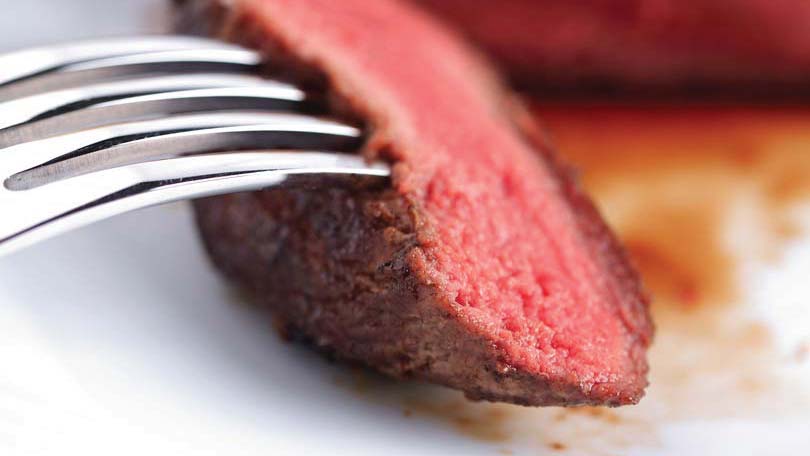Nowadays, it seems we can’t do anything right, or safe. Don’t eat this, don’t eat that, don’t drink this, don’t breathe……’ If all of the cautions are true, it makes you wonder how the heck the human race manages to survive from year-to-year. But survive, we do, and very well, if the 2010 Census is even close to accurate. Fear-mongers tell us not to eat raw meat, that well-done meat causes cancer, and now, there are some who even question medium-rare meat, and of course, the extremists who say that all meat is bad. They can’t all be right, can they? How can we answer the question: Is medium-rare steak bad for you?
Meat, in an of itself, does have some very slight health risks associated with it. Pork and chicken can carry parasites. Pork, especially, is famous in by-gone eras for causing trichinosis, a debilitating disease caused by a nematode (unsegmented roundworm parasite) in pigs and hogs. It is the basis for the prohibition of eating pork in many of the worlds religious food laws. In the Old Days, they didn’t understand that cooking pork to 160’°F destroys all food-borne, disease-causing microbes and parasites. Chicken is notorious for being contaminated with E. coli, a disease-causing bacteria that can also be present in ground beef. E. coli contaminations are caused by the processing conditions, rather than anything in the meat itself, and again, cooking to at least 160’°F, and using good kitchen sanitation procedures eliminates this danger. Fish can contain some parasites that are destroyed by cooking, but the danger of fish is mainly from it’s rapid decomposition properties. Of all the meats commercially available in the U.S., whole beef cuts represent the least amount of risk for food-borne illnesses. There is a possibility that there may be an extremely slight (almost negligible) elevated cancer-risk from the Heterocyclic Amines, and Polycyclic Aromatic Hydrocarbons, naturally-occurring chemicals present in anything that burns, but you have a much better chance of winning the lottery, so it is not worth worrying about. Overseas, there is a slight risk of Mad Cow, but no cases have ever been reported in the US, so far. The only other parasite that beef may harbor is Toxoplasma gondii, but there are only around 300 cases of it yearly, so it’s not really much of a health concern. You stand a much better chance of winning the Big Ten, so my advice would be to fire up the grill, buy a few lottery tickets, and figure out where you’ll spend your millions if you win.
Most health concerns revolve around the eating of absolutely raw beef, such as in Steak Tartare. The risk here is E.coli. E. coli contamination is caused by the processing plant allowing animal feces to come into contact with the meat after it is cut, or ground. The bacteria are present in the intestines of almost every animal, including humans. It aids in the break-down of foods, so that the nutrients can be used by the body. As long as they stay where they belong, they are harmless, but when they wind up in places where they do not belong, they cause diseases such as peritonitis, and E. coli’ food poisoning. The normal and legal requirements for food handling are more than adequate to safeguard against this happening, but every once in a while, a processing plant will get sloppy and lazy, and circumvent the safety procedures, resulting in occasional recalls of their products. Cooking your meat to 160’°F destroys E. coli. Also, except in the case of ground beef, any E. Coli contamination will be on the outside of your meat, and it washes off easily. If you plan to eat rare or medium-rare steaks, or roast beef, (internal temperature of 135’°F-140’°F or less), simply rinse them off well before cooking them, and make sure you wash your hands after rinsing the steaks before handling them again. Chlorine in the water doesn’t hurt, either, and that’s the only time you won’t hear me complain about chlorine in the public water supply.
A study done at the University of Nottingham, in the UK, in 2004, showed that rare beef, even when purposely contaminated with E. coli, was safe to eat when cooked ‘rare’ as long as the utensils and prep surfaces where cleaned using normal kitchen sanitary procedures. None of the meat showed any surviving bacteria, except where they were touched by an uncleaned knife or other utensil. In the tests, the surviving E. coli were from re-contamination from the tongs used to turn them. The study proved that rare steak can be eaten safely provided that bacteria are not reintroduced by contaminated utensils. Good news for those of us that like our steaks lightly-cooked.
After an exhaustive internet search, I could find no evidence from any reputable source that the consumption of medium-rare steaks poses any unique health risks whatsoever, so you should feel free to order, or cook your steaks however you like them, and bask in the exquisite taste, smell, and aroma of an expertly prepared ribeye, sirloin or T-Bone.






